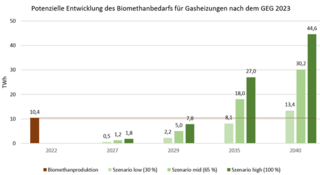Growing demand for biomethane in the building sector?
Toni Reinholz, Renewable Energies Team Leader, and Christin Schmidt, Renewable Energies Expert, on the biomethane required to fulfil the German Buildings Energy Act by 2040.

The German Buildings Energy Act aims to make the building sector more climate-neutral by reducing greenhouse gas emissions and at the same time promoting the increased use of renewable energies and unavoidable waste heat. An increasing demand for biomethane could arise in the building sector under the current framework conditions of the Buildings Energy Act if new gas heating systems continue to be installed in the future and hydrogen production does not increase at the planned rate in accordance with Germany’s National Hydrogen Strategy. A new analysis by dena has calculated the potential biomethane requirement to fulfil the Buildings Energy Act by 2040. Toni Reinholz, Renewable Energies Team Leader, and Christin Schmidt, Renewable Energies Expert explain the main findings.
Need for action in the German heating supply
Heat accounts for more than 50 per cent of Germany’s total final energy consumption. It is used in a variety of ways for space heating/air conditioning, hot water and process heating or cooling. Slightly less than a quarter of final energy consumption is used by private households for heat generation.
Heat generation is currently mainly based on natural gas and mineral oil and produces around 90 million metric tons of CO2 every year. The heating sector is therefore one of the key areas for achieving the goals of the energy transition and utilising more renewable energies.
What is biomethane? And what role does it play in the heat supply?
Biomethane is a gaseous renewable energy source that consists of the combustible gas methane and, unlike natural gas, is produced from biogenic raw materials. It is the main component of biogas, which is produced by the fermentation of biomass with the help of microorganisms in the absence of oxygen in biogas plants. In order to process biogas into biomethane, the biogas must be desulphurised, dried and the carbon dioxide separated.
Due to its similar properties to natural gas, biomethane can be used in the electricity, heat and fuel sectors. Among the renewable energy sources, biomethane is currently only of minor importance in our overall heat supply. The share of biomethane in heat generation from renewable energies in Germany was only around 2 per cent in 2022 (source: AGEE-Stat). The production of biomethane in Germany in 2023 was around 10.4 TWh, most of which was converted into district and local heating and electricity in combined heat and power plants (source: Biomethane Industry Barometer for 2023).
Biomethane in the Buildings Energy Act: Potential increase in demand
The new publication entitled ‘How will biomethane demand develop on the basis of the Buildings Energy Act?’ calculates the potential development of biomethane demand under the regulatory requirements of the German Buildings Energy Act up to 2040.
The demand for biomethane could increase significantly by 2040 based on the current structure of the Buildings Energy Act. The piece of legislation still permits the installation of gas heating systems on a large scale under specific conditions. However, these must be gradually convert to being fuelled with higher proportions of renewable energy sources such as biomethane or hydrogen. However, if sufficient quantities of hydrogen are not available for use in buildings by 2040, the additional demand for biomethane could rise to between 13.4 and 44.6 TWh by 2040, according to the dena analysis.

This potential additional demand could arise for the following reasons:
- Gas heating systems installed outside of a heating plan from January 2024 onwards must get 60 per cent of their heat from biomethane or hydrogen by 2040
- Gas heating systems installed in municipalities with a heating plan must be supplied with 65 per cent renewable energy, unavoidable waste heat or a combination of these
- Gas boilers that are installed as peak load boilers in newly built apartment buildings must in turn use 65 per cent renewable energy
Where is there potential for biomethane use?
The calculated biomethane demand could be covered by the following measures:
- Mobilisation of waste and residual materials: depending on the study, the previously unutilised biomethane potential from waste and residues is estimated at 40 to 71 TWh.
- Biomethane imports from European countries: the REPowerEU plan developed by the European Union aims to increase biomethane production by around 370 TWh by 2030. In order to achieve this goal, there are plans to increase biogas production capacities in the EU and to promote the conversion of biogas into biomethane. These measures will require an estimated investment of around €37 billion.
According to the Renewable Energy Directive (RED III), all plants with a rated thermal input of more than 2 MW must achieve 80 per cent minimum greenhouse gas savings by 2030, which makes the prospect of an additional increase in biomethane potential from energy crops less likely.
